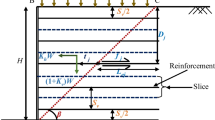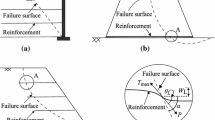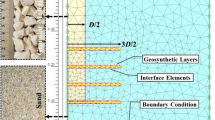Abstract
In this paper, a new approach for back analysis of a geogrid reinforced soil (GRS) wall failure is presented. A new zero-thickness cohesive fracture element is utilized to simulate the slip surface behind the GRS wall. This element can simulate displacement discontinuity as well as tractions across the shear band effectively. The numerical results are compared with the measured values from the physical test as well as the obtained values from the typical finite element method. This paper demonstrates that the proposed finite element algorithm via discrete modeling of the shear band can effectively improve the quality of numerical back analysis of the soil failure which explains its necessity.










Similar content being viewed by others
References
Allen TM, Bathurst RJ, Berg RR (2002) Global level of safety and performance of geosynthetic walls: an historical perspective. Geosynth Int 9:395–450
Santos ECG, Palmeira EM, Bathurst RJ (2013) Behaviour of a geogrid reinforced wall built with recycled construction and demolition waste backfill on a collapsible foundation. Geotext Geomembr 39:9–19
Karpurapu RG, Bathurst RJ (1995) Behaviour of geosynthetic reinforced soil retaining walls using the finite element method. Comput Geotech 17:279–299
Tafreshi SN, Nouri TA (2014) A simplified pseudo-static seismic analysis of reinforced soil walls with uniform surcharge. Int J Civil Eng 12(2):97–109
Ling HI, Tatsuoka F, Tateyama M (1995) Simulating performance of GRS-SW by finite element procedure. J Geotech Eng ASCE 121:330–340
Yoo C, Jung H (2006) Case history of geosynthetic reinforced segmental retaining wall failure. J Geotech Geoenviron Eng ASCE 132:1538–1548
Keshavarz A, Ebrahimi M (2016) The effects of the soil-wall adhesion and friction angle on the active lateral earth pressure of circular retaining walls. Int J Civil Eng 14:97–105
Aldeeky H, Al Hattamleh O, Alfoul BA (2016) Effect of sand placement method on the interface of sand and geotextile. Int J Civil Eng 14:133–138
Rudnicki JW, Rice JR (1975) Conditions for the localization of deformation in pressure-sensitive dilatant materials. J Mech Phys Solids 23:371–394
Palmer AC, Rice JR (1973) The growth of slip surfaces in the progressive failure of overconsolidated clay. Proc R Soc Lond A 332:527–548
Lai TY, Borja RI, Duvernay BG, Meehan RL (2003) Capturing strain localization behind a geosynthetic-reinforced soil wall. Int J Numer Anal Methods Geomech 27: 425–451
Cooper MR, Bromhead EN, Petley DJ, Grant DI (1998) The Selborne cutting stability experiment. Géotechnique 48:83–101
Samaniego E, Belytschko T (2005) Continuum-discontinuum modelling of shear bands. Int J Numer Methods Eng 62: 1857–1872
Barani OR, Khoei AR, Mofid M (2011) Modeling of cohesive crack growth in partially saturated porous media; a study on the permeability of cohesive fracture. Int J Fract 167:15–31
Barani OR, Khoei AR (2014) 3D Modeling of cohesive crack growth in partially saturated porous media; a parametric study. Eng Fract Mech 124–125:272–286
Barenblatt GI (1962) The mathematical theory of equilibrium cracks in brittle fracture. Adv Appl Mech 7:55–62
Dugdale DS (1960) Yielding of steel sheets containing slits. J Mech Phys Solids 8:100–108
Khoei AR, Barani OR, Mofid M (2011) Modeling of dynamic cohesive fracture propagation in porous saturated media. Int J Numer Anal Methods Geomech 35: 1160–1184
Bathurst RJ, Benjamin DJ (1990) Failure of a geogrid-reinforced soil wall. Transp Res Rec 1288:109–116
Camacho GT, Ortiz M (1996) Computational modeling of impact damage in brittle materials. Int J Solids Struct 33:2899–2938
Khoei AR, Moslemi H, Majd Ardakany K, Barani OR, Azadi H (2009) Modeling of cohesive crack growth using an adaptive mesh refinement via the modified-SPR technique. Int J Fract 159:21–41
Gui Y, Bui HH, Kodikara J (2015) An application of a cohesive fracture model combining compression, tension and shear in soft rocks. Comput Geotech 66:142–157
Song SH, Paulino GP, Buttlar WG (2006) A bilinear cohesive zone model tailored for fracture of asphalt concrete considering viscoelastic bulk material. Eng Fract Mech 73:2829–2848
Khoei AR (2005) Computational plasticity in powder forming processes. Elsevier, UK
Author information
Authors and Affiliations
Corresponding author
Rights and permissions
About this article
Cite this article
Barani, O.R., Bahrami, M. & Sadrnejad, S.A. A New Finite Element for Back Analysis of a Geogrid Reinforced Soil Retaining Wall Failure. Int J Civ Eng 16, 435–441 (2018). https://doi.org/10.1007/s40999-017-0150-6
Received:
Revised:
Accepted:
Published:
Issue Date:
DOI: https://doi.org/10.1007/s40999-017-0150-6




